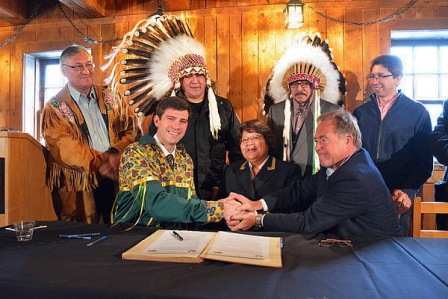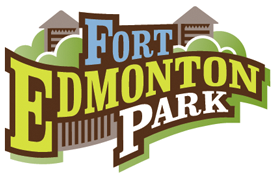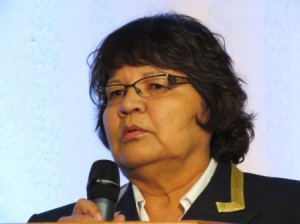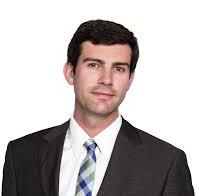On January 29, 2015 Fort Edmonton Park senior management and the Confederacy of Treaty Six First Nations signed an historic memorandum to work together to honour the true history of the Aboriginal people in Alberta. Edmonton Mayor Don Iveson witnessed the signing.
The entire project, which will include a new Indigenous Peoples Experience, is expected to take several years to complete and cost about $50 million. Before the new upgrades can be built, however, the plumbing, electrical and sewage systems at Fort Edmonton will have to be upgraded. That’s going to cost another $50 million. Some outside investment, perhaps from the province, could be needed to ensure the success of the project. The bottom line, said the partnership, is to make it happen and make it happen right.

Mayor Don Iveson, Treaty 6 Grand Chief Bernice Martial and Fort Management Company Board Chair Doug Goss unite in partnership as they sign historic agreement. Article by John Copley; photo supplied
“It’s going to be authentic; it’s going to be the way our First Nations partners want it to be,” assured the chairman of the Fort Edmonton Management Company’s Board of Directors, Doug Goss. He made it clear that there will not be any bells and whistles and imaginary tourist attractions, but instead an historic heritage site that will encompass the reality of the time.
He said, “It’s going to be absolutely authentic; no Disney. There’s going to be absolute historic integrity. We are not just going to tell happy stories; it will be about the good, the bad and the ugly.”
Goss went to note that “Aboriginal culture was the foundation this city was built on. That needs to be celebrated; there needs to be a place to keep it well and for it to be nurtured.”
The document, signed at Fort Edmonton by Chiefs of Treaty Six First Nations and Goss, reaffirms the long-term commitment between Fort Edmonton Park and the Indigenous nations upon whose territory the original fort was built. But more than that, this new understanding comes with new commitments that will put the roles and achievements of First Nations in a perspective that will encompass reality, shed the truth and enlighten visitors in ways they’ve not seen before. The new agreement comes with new attitudes and renewed hope that by creating the reality of yesterday today, myths will be dispelled and a new sense of reality will ensue.
“The signing of a new agreement with Fort Edmonton was a very happy moment for me, a special moment that has been a long time coming,” smiled Treaty Six Grand Chief Bernice Martial, in a conversation a day after the historic signing. “Yesterday we made history; tomorrow that history will be shared with Albertans and every visitor who makes his or her way into Fort Edmonton.”
Attending the Fourth Annual Treaty Six Educator’s Conference the day after the historic agreement was signed, Grand Chief Martial said she was “very happy and absolutely encouraged by the success of this outstanding conference” and “extremely pleased with yesterday’s signing of an important memorandum that will finally recognize who we are as Aboriginal people.”
The new agreement also promises to recognize the achievements and the sacrifices that First Nations have made in the growth of this region and the province as a whole. Martial said she wants the new agreement to recognize and include all of Alberta’s First Nations.
“I mentioned that to Mayor Iveson when I spoke to him at the signing,” noted the Grand Chief. “I’d also like to see something that highlights our languages with focus on the importance of (maintaining) them and teaching them to our children. Mayor Iveson has been a voice for Aboriginal people since taking office; he lives up to his word and keeps his commitments. He is sincere; he listens and he continues to show a willingness to work closely with Aboriginal people and their issues. He hasn’t made promises but he, and everyone involved in this initiative, is committed to working with First Nations to ensure that our story is told.”
She said the new agreement, and the new focus at Fort Edmonton Park, will help to change the way that non-Aboriginal Canadians think of the past, and lauded everyone involved in helping to bring this new agreement to fruition.
Built in 1846, in the middle of the fur trade era (1795-1859), Fort Edmonton was first opened as a Hudson’s Bay Company trading post. No longer original, Fort Edmonton has see much growth and change over the years but the one thing that’s remained constant since it became a tourist attraction back in 1974 is the fact that it never really showcased or highlighted the Indigenous peoples of the region. Yes, Aboriginal people have played some minor roles and do have a tipi encampment of sorts outside the fort wall, but their history was never shared, their sacrifices never understood, their contributions seldom recognized.
The roles of the settlers, fur companies, trappers and traders have dominated the theme at the popular attraction since it first opened for business. Most of the narrative and recognition has gone to the English, French and Scottish immigrants who came west to trap and trade, grab free land and search for riches. During the past few years the park has made attempts to bring a better awareness to visitors about the roles that Aboriginal people played in the establishment of the region. Interpreters and actors dressed in traditional regalia can be found throughout the park during the summer months as they move about the fort, most remaining firm in their attempt at originality and realism. But for the most part, the Aboriginal side of the story is missing.
Mayor Iveson said he’s well aware of the missing components at Fort Edmonton; as did Doug Goss. They are both on board for the significant changes that will have to take place if the realism of the day is to be truly shared and understood.
“When this started out (Fort Edmonton as a tourist attraction) it really was a colonial history, a settler’s history, with barely an acknowledgement of interaction with Indigenous people,” Mayor Iveson told those who’d gathered to witness the signing of the memorandum. “We know there is so much more to this history; that there was mutual aid, there was interdependence.”
Goss agreed, noting, “What’s different this time is that we won’t program anything unless we get absolute consensus from our First Nation’s partners. It has to be what they want to say in the way they want to say it.” Goss added that the Fort Management is also talking to the Metis Nation of Albertato see if they want to join project.
The Memorandum of Understanding (MOU) states: “That the staffs of Fort Edmonton Park and the Confederacy of Treaty No. 6 First Nations will collaborate towards ensuring that the integrity of historical and cultural programming is inclusive of members of the Confederacy of Treaty No. 6 First Nations, and that the Confederacy of Treaty No. 6 First Nations and their members are included in capital development processes of Fort Edmonton Park when it impacts the historical and cultural narrative of First Nation peoples of this territory, and that the building of experiences at the park is a shared endeavour.”
The Confederacy of Treaty Six First Nations was created in 1993 with the purpose of serving as the united political voice of those treaty nations who are signatories of Treaty No. 6. Edmonton is located in Treaty No. 6 territory and an adhesion to the treaty was signed in or near the original Fort Edmonton on August 21, 1877.
by John Copley






Be the first to comment on "Treaty 6 partners with Fort Edmonton Park for authentic representation"